By Brent T. Wheat
One of the coolest things about the Modern Sporting Rifle (MSR), built on the well-known AR-15 platform originally designed by Eugene Stoner, is the fact that the system is largely modular and can be assembled and modified by anyone possessing some basic tools and a bit of mechanical aptitude. Happily, for firearms enthusiasts, “easy to assemble” also translates to “easily customizable”. The concept has been so successful that the AR-15 and its countless variants have earned the names, The Swiss army knife of guns, frankengun, LEGOS for adults and others.
Assuming all the individual parts are within specification, a builder only needs to verify chamber headspace and mechanical function before heading to the range with their completed rifle. Of course, that doesn’t mean the gun will be “a shooter,” as considerable experience and skill are required to build a highly accurate rifle. Generally, however, a frankengun will usually perform safely and reliably, even if the builder doesn’t possess major gunsmithing chops.
For these reasons, every hardcore firearms enthusiast eventually considers buying, building or modifying their own “ultimate” MSR. The idea of having a personalized rifle is highly appealing, but it’s often a practical matter as well. What one shooter considers the supreme MSR might be nearly useless for someone else. A 3-gun competitor has far different needs than a special-forces operator. Similarly, someone teaching their spouse to use a rifle for home defense doesn’t have the same set of requirements as a police officer. Likewise, building a gun for coyote hunting at 500 yards is different than building a rifle to take out feral pigs at tag-you’re-it distances.
That’s why it’s smart to consider the intended purpose of the gun before everything else.
Decisions can then be made regarding complete guns or individual components that best serve the guiding purpose. For example, a varmint hunter might prize accuracy above all, while a cop or solider places reliability at the forefront. The more one can define the role and overall requirements of their pending build or purchase, the greater the rewards will be later.
Once the important concepts have been identified, it’s time to decide whether your wish list is available on a production gun, whether you’ll have a reputable builder assemble your custom or semi-custom rifle for you, or if you’ll start acquiring the necessary parts and complete the build yourself. The big problem isn’t finding information, opinions or the parts; enjoy the process, because there’s plenty out there. Rather, it’s winnowing down the overwhelming number of choices into something manageable.
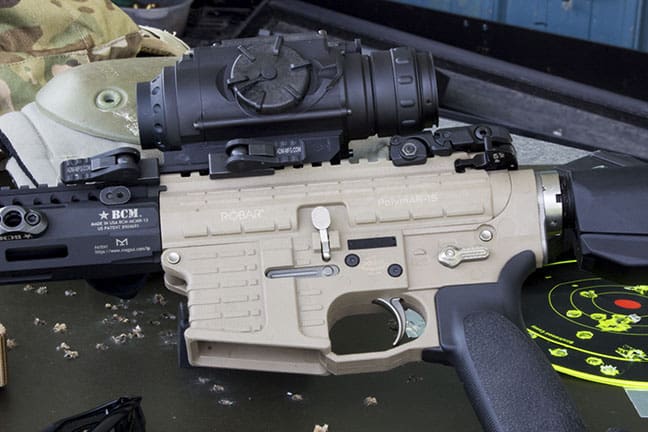
Our Needs
In my case, I place a high value on expertise and experience. I wanted a lightweight, reliable rifle with sub-MOA accuracy, but also wanted to learn as much as possible about putting one of these guns together to share with my readers.
Ultimately, I found that expertise at Robar Guns in Phoenix, Arizona, and opted to start with their PolymAR-15Ti – a solid example of a premium, commercially available rifle that is assembled using the finest quality parts from a variety of sources across the industry. Not only does this rifle meet my baseline needs with respect to weight and performance, the people who make it have decades of accumulated experience building these weapons, so their choices speak volumes for the home builder.
The end user of this gun, according to Robar CEO Freddy Blish, is the soldier, police officer or hunter who will hump the gun long distances and needs a rugged, totally reliable and highly accurate weapon. “The goal was to go light,” Blish says, “for situations where you might be carrying the gun for long periods of time. You know, ounces are pounds and pounds are pain!”
Blish also acknowledges a secondary market: “I don’t want to say that the PolymAR-15Ti was designed for smaller-statured people or women, but those customers have become a good audience for us because they love the light weight.”
Weighing in around 4.75 pounds, nearly two pounds less than the average MSR, the Robar gun comes with guaranteed sub-MOA accuracy with appropriate ammo.
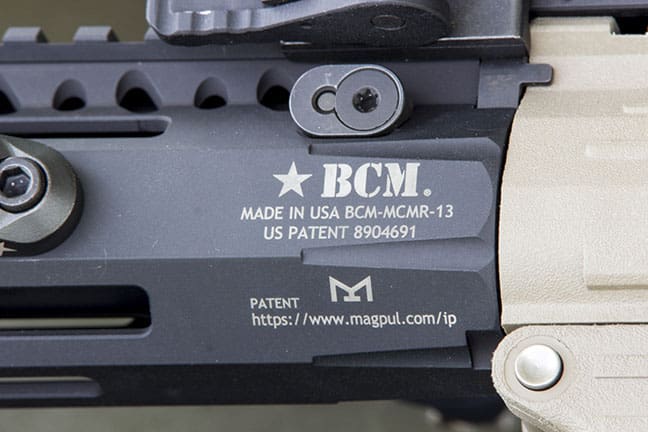
Our Rifle
The PolymAR-15Ti is built around a Kaiser Shooting Products Gen 2 Polymer Upper and Lower receiver set, which is available in three colors. This new action housing has more 7076 hard-anodized aluminum reinforcement in the lower receiver and uses a new polymer composite that is five times stronger than steel for its weight. Blish and his highly experienced gunsmiths chose the KSP components not only for their weight, but also because their strength reduces flex during cycling, which greatly enhances reliability and accuracy. “Many of our customers need to trust their life to it (the PolymAr-15). We understand that and won’t compromise there,” Blish says gravely.
The weapon’s furniture comes from the Bravo Company Gunfighter series. Several other parts such as the charging handle, fore end, barrel nut and sling mount are also from Bravo. The Bravo fore end uses the KeyMod system and sports a BCM Model 3 vertical grip.
The barrel is a Faxon 1:8 5.56 NATO model mated to a V7 Weapons Systemtitanium, low-profile gas block. Likewise, the titanium QD receiver end plate, castle nut, pivot pin, takedown pin, magazine catch, mag catch button, selector switch and flash hider are also from V7. You can also order a BattleComp 1.5 Ti flash hider.
The Robar Mil-Spec Bolt Carrier Group is custom manufactured from P6 steel (Carpenter 158) and sports their well-known proprietary NP3 surface treatment that combines Teflon with electroless nickel for an unbelievably durable, slick finish. The trigger assembly is an enhanced Robar Mil-Spec group coated in NP3.

Topping It Off
The flat top receiver on the PolymAR-15Ti comes standard with a MagPul MBUSbackup front and rear folding sight set. On our test gun, however, we wanted to add daytime and nighttime targeting capability, while keeping an eye on overall weight. Ultimately, we chose the compact FLIR ThermoSight PRO PTS 233 thermal-imaging scope as the primary optic for our featherweight MSR.
The FLIR ThermoSight PRO PTS233 was an easy choice for several reasons, but primarily because it sets the bar in the current market for size, weight, power, and performance.
Weighing less than 24 ounces, the compact PTS233 is powered by the FLIR Boson thermal camera core, delivering smaller, lighter optics with increased image performance and range. The FLIR ThermoSight PRO PTS233 offers improved object detection and classification in the field and clean thermal imagery in any light—from low contrast daylight to total darkness—or through light smoke, haze or fog. Additionally, its 19mm-lens produces a 12-degree field-of-view (FOV), which is ideal for close- to medium-range applications. A 4X digital zoom delivers increased versatility and extended range. I also liked the fact that the PTS233 offers multiple thermal imaging palettes and shot-activated, onboard recording of still images and videos. And all of this comes for a price below $2,200—less than many would spend for a quality, day-only optic.
For those seeking additional range in a thermal scope, FLIR offers two other compact and lightweight models in their new ThermoSight PRO line: the 50mm PTS536 with a 4.5-degree FOV (1.65 lbs.) and the 100mm PTS736 with a 3-degree FOV (2.14 lbs.).
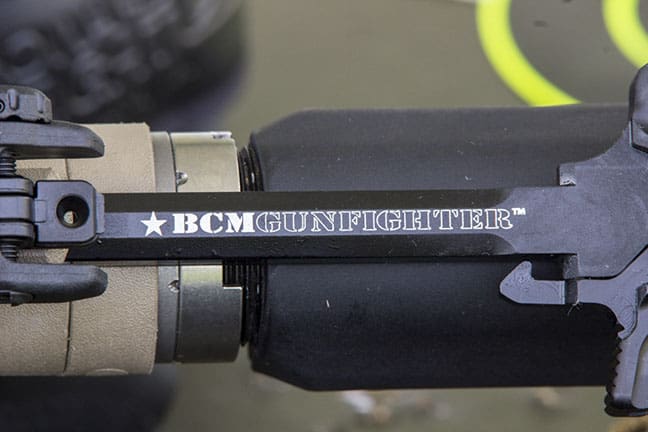
Tips for the Home Builder
For the would-be home builder, Blish says there are three key components to building a quality MSR: a good quality receiver set, bolt carrier group, and barrel. He also points out that the trigger group is another area where improvement can be especially valuable. “You really have to work to get a good barrel shooting well with a bad trigger, whereas a good trigger can really help with a less accurate barrel,” the retired Marine Lt. Col. notes.
Cost is often a major motivating factor for building an MSR, and while building a complete rifle at home can definitely save money, scrimping on parts is a fool’s errand. There’s usually a good reason why one component costs more than another. “You know,” Blish points out, “Pat (famed AR-15 expert, Pat Rogers) used to say, ‘buy once, cry once.’ He’s right. I value quality over price anytime.”
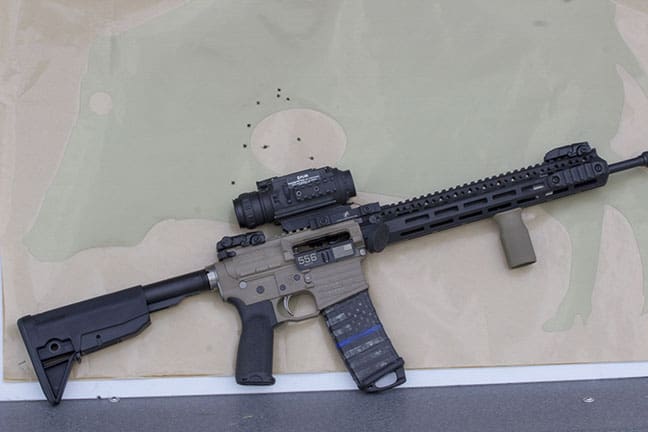
A custom rifle built on the AR-15 platform is certainly within reach of most shooting enthusiasts, should they decide to take the plunge. The only major downside is the fun and satisfaction involved. Yes, I said downside, because once the first rifle is completed, the urge to build another (and another) only grows exponentially. It’s an itch that can’t be ignored.
I recommend you scratch it.

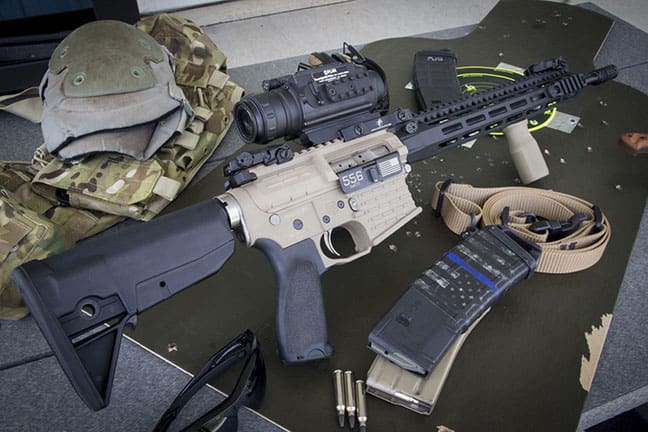
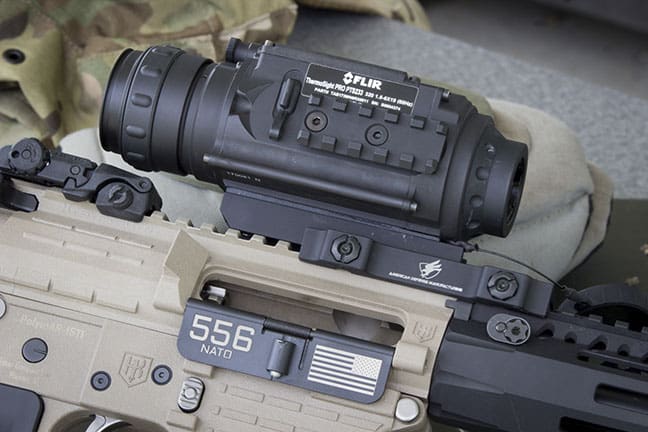


…Barbie doll for boys… you forgot barbie doll for boys.
Arm and a Leg! Or First Born…
Built my first, liked it so built another. At last count i could outfit a platoon of i had to. Ha. Each tweaked to fit a niche.
There should really be an ‘AR Assembler’s Support Group”. That first build starts the slippery slope into madness 🙂
i value value over price anytime
i dont buy into this whole the more expensive it is the better mindset
most often times a complete rifle or component that costs 2 to 3 times more aint no 2 to 3 times as good
its only marginally better at most
none of my builds cost me more than $900 with a vortex or primary arms optic on it and all shoot under 1 moa to at least 100 yards with the right ammo and all have run flawlessly and will all get me out of greater than 98 percent of any jams i may ever find myself in
theres plenty of videos on youtube of competent experienced shooters with their $2000 rifles with $1000 scopes on them not shooting significantly better than my $700 rifle with a $200 scope on it
im not taking my rifles to afghanistan
im just taking them to the range the woods and my front door in the middle of the night if need be and all of them will do whatever i ask of them without breaking the bank
Good post. Whatever works for you. Some people like the pricey and newer stuff, it’s their money I don’t care there are thousands of options in the gun world for everybody to find happiness. If I had more $ there are quite a few “toys” I would like to put in the safe, nothing I would never used however. To be back on the MSR topic, I have a BCM mid length upper with FSB, a mil spec Spikes lower (just replaced the A2 style grip for the BCM grip). Magpul handguard with BCM vert foregrip. Blue Force Gear Vickers 2 points sling. I love it. I just need a light (thinking about inforce) and maybe a red dot, we will see in a couple of months with reduced prices and good deals.
I’ve noticed that reducing weight usually requires higher cost, such as the titanium parts in the article’s rifle. Out of curiosity, how much does your rifle weigh?
I am on a fixed income, and generally a cheap bastard. I do, however, understand when a part should cost $X and I find some for 65% less than $X, it’s likely crap…so I look a little higher on the price range.
I do group buys with friends for bulk pricing. The range on my property is only 150yds, and CQB is very short range, and I’m not in competition with anyone but me, so “precision” is not a factor. I’m OK with making 2 holes with 2 bullets. My tastes run to Chevy vs BMW. I’d rather build several specifically kitted units than one hyper expensive platform.
I have…several…AR pattern units. My favorite overall is one I built myself and cost me $350 (patiently waiting for sales or deals) back when the budget units cost $600+. Totally reliable, and I would stake my life on it.
I’m going to need a picture of that thing on a scale before I believe it weighs 4.75lbs.
My dick weights 2lbs. Give me your cell I’ll send you a pic of the beast on a scale.
” someone teaching their spouse to use a rifle for home defense doesn’t have the same set of requirements as a police officer. ”
How? Otherwise basic 5.56 AR with pencil barrel, decent (light) freefloat tube, taclight, an improved trigger and red dot is perfectly suited for both a home defense gun or an officer’s trunk. Even if you put emphasis the “teaching” part, the spouse still needs to practice with 5.56 in the end and not just a 22 upper. Only possible difference is budget (laser, higher end optic) and legal (NFA).
If it has a suppressor on it so your don’t ruin your hearing permanently by firing it indoors without hearing protection.
Most people don’t NEED a free floating rail. Not saying I have anything against anyone putting a decent or even very nice and pricey one. You can pull a 2 piece drop in Magpul or Midwest Industry handguard and be good to go, be it for home defense or law enforcement. I agree on your main point however, specs for HD and LE aren’t necessarily different, except for SWAT maybe.
Free floating rail was a meme from the start. My magpul handguard works as well as any other AR.
I am finishing my third build now. It has been pricey but I buy the parts on sale over time, almost 2 years now. My build is in black and FDE:
Noveske VLTOR upper
BCM BCG
BCM lower
Rise Armament 16 inch nitride barrel in .223 Wylde
Geissele trigger
Geissele MK14 15 inch rail
Geissele Super Charging Handle
BCM grip
SLR Rifleworks barricade handstop
Battle Arms Development ambi safety
Wilson Combat Mariner bolt catch
OdinWorks enhanced mag release
VLTOR Emod stock
VLTOR flash hider
Diamondhead BUIS
Eotech 512 optic
Sightmark lopro laser (just for fun)
You definitely didn’t go with budget items. I am sure it will turn out to be a sweet AR. Have fun.
You lost me at Polymer Lower and Upper. For me those are parts that need to be M E T A L.
100% right.
I’m glad you want to use metal, but it’s not needed.
I’ve neen going back and fourth about what I want in my next AR. I’m aiming toward a suppressed SBR type set up. But not exactly sure on which caliber and wether to go integrally suppressed or not. I know .300BO is the optimal round for that set up, but my concern is the longevity of that round. It’s found a fairly decent market but I’ve seen a lot of calibers come and go over the years. I’m sure it’ll still be around in 10-20 years but at 1$-2$ a round after the fad dies down… that would be stupid.
That’s the cool thing about MSR’s though. If 300BO is a fad caliber, just change barrels. That’s it. Nothing else.
Honestly haven’t thought about that. Great point.
Buy the dies and load it. Then you can extend the fad indefinitely. Cheaper than a barrel and more rewarding.
My understanding of the sport is that blackout is the best caliber for running subsonic and suppressed from an AR-15 platform. That should keep it fairly mainstream even if we never get something like the Hearing Protection Act. On top of that, it’s very versatile in it’s usage, fantastic for hunting boar, and you don’t even need to buy new mags for it. I think it’s here to stay.
If you want to shoot a lot of 300blk you really need to reload it, but once you’re set up for that the world’s your oyster. I consider it a “garbage disposal” round, you can basically shoot just about any type or weight of 308 caliber bullet with good results. I have a “pistol” and a ruger ranch that I shoot it out of, along with my Dead Air Sandman-S. I Load sub and super sonic rounds with H110 with good results!
Not sure about “the system is largely modular and can be assembled and modified by anyone possessing some basic tools and a bit of mechanical aptitude”
I assembled mine, but some days I have zero or negative “mechanical aptitude”. In fact some days I am so clumsy I am lucky to have lived so long. Yet, my self assembled AR and I can shoot softballs at 200 yards. A nice barrel, free floated rail, and trigger deserve some credit. But also, all 10 of my thumbs. So if I can assemble an AR, literally anyone can.
Stay as close to the military specifications as possible. Keep it simple.
A Colt 6920 with a KAC rail (or DD RIS II), surefire weapon light, and optic (aimpoint or quality middle road magnified optic) will serve you nicely as a world class rifle and probably outlive the average owner.
Good choice and reasonably priced…
My AR15 budget build:
FN15 $1500
KAC RAS II $700
DD M4 $800
Larue Stealth 20″ Bbl $230
OSS Keymod Tube $130
KAC 2 Stage match trigger $400
Larue MBT2 $125
Magpul PRS $220
Primary Arms 4x ACSS $230
Burris PEPR 30mm QD $125
MAGPUL Ergo grip $35
Krylon $65
Bushnell AR Optics 1-4 $175
Larue Stealth Upper w/handguard $350
Bushnell LRST 3.5-21 $750
TPS Rings $125
Pic to pic riser $48
CLE Upper $985
This doesnt include the cost of reloading components or having to listen to the wife bitch endlessly.
I hate to ask this but why do you need a receiver set that’s “quality?” I am taking that as “fancy.” I mean, how many guns are built on basic Anderson/PSA/some other lowers and are just fine? “People” say that they are stiffer and can therefore increase accuracy but I have as of yet to see anyone put quantity to that.
Bad upper is conceivable, but there’s no real difference I’m aware of from any good company in that part. Bad aluminum lower is virtually unheard of, worst I’ve ever heard of is the Anderson lowers with non-standard grip screws. No reason to buy any fancy lower unless you want the roll mark or it’s something really unusual like a GWACS lower.
Which was honestly awesome. It hurt their rep, but they always have fire sale prices and still work fine. I’m slowly working on two right now
I want to build a lightweight AR, but I’m leaning toward Battle Arms lightweight receiver sets. I just can’t get into the polymer receivers even though I know they work.
Considering how much money spent on their AR “Build(s)” some of these commentors stated, My AR-15 wasn’t so much a “Build” per say but I still ended up spending less for my setup. Complete AR-15 – Ruger AR-556MPR $600, Leupold VX-R Patrol 1.25-4x Scope $400, VTAC Rifle Sling $50, AR-15 Carrying Case $40.- 55gr/62gr/73gr/77gr Ammo $400.-
I have a hard time dropping $2k+ on an optic, especially one that depreciates with use and time.
I get it, just hard to fathom. My butt was sitting in Afghanistan it would be worth it.
Anyhow. Having built dozens of these, generally once each has broken in, the window between a budget build and a very expensive build narrows quickly as far as accuracy and reliability go.
As stated above, you don’t always get what you pay for, sometimes you have to pay 5 times the cost for 20% better performance, compound that over 15 parts on the weapon and the end costs get pretty high but the weapon is still only 20% better on average than a budget rifle.
The real key with building AR’s is to be honest with yourself as to the use of the rifle.
If you know its not going to see thousands of rounds a week, a chrome bore might not be necessary.
If you aren’t really going to pedal that thing for 20-30 miles a day, 5 days a week on foot, is it worth spending $500 extra to shave 3/4 of a pound? Not really.
Lately my theory has been, its better to have 3 durable and reliable complete weapons, than 1 top end one.
I use this logic on a lot of people I talk to who, you know the ones, only own one or two firearms.
Hey, lots of people can’t afford any more than one. But they feel that if that one AR is built to the absolute top notch, it will perform like an Indy car during a SHTF event. But then I explain how one unforeseen failure of a part can render their entire arsenal useless. Then it becomes clear that instead of $5000 in one rifle, you can have 5- $1000 rifles that shoot just as well, in addition to having a functioning backup, you can arm a friend as well.
Thoughts…..
You nailed it. The point of diminishing returns where the benefit isn’t worth the cost associated to it.
2MOA is good for any battle rifle. Two is one, one is none. Best get 4 for the price of 1.
Stopped reading as soon as I read something about polymer.
wikiarms led me here:
https://22mods4all.com/collections/firearm-kits-bundles
18″ wylde 1:8 twist sounded good. with a bcg and a lower this is under four bills. i dropped in a larue and find it pretty hard to miss stuff with cheap rounds.
it’s a good time to do this.
basically there are two reasons to build an AR: show off or shoot. your reason was the first.
Another reason would be writing nice little infomercial like they do in dead tree magazines to sell more overpriced components. But that can’t happen here on TTAG.
My ultimate AR-15 Build, NOT…
( http://www,imfdb.org/wiki/File:ZF-1_500.jpg )
Step 1 – Buy an AK-47.
Step 2 – Go have a beer.
I’ve been planning a build for a while now, but I don’t know when I’ll be able to start. There’s a local shop that makes some very nice lowers. What I want to do is get an AR-57 12″ upper with a full auto bolt, then use a Fostech Echo II trigger group. Ammo is somewhat expensive, but those things are FUN. There’s a couple of videos on Youtube of one.